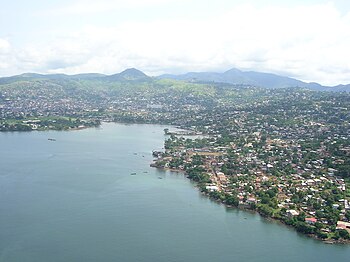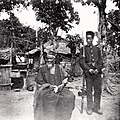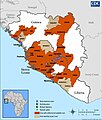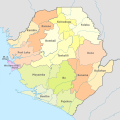Portal:Sierra Leone
The Sierra Leone Portal  Sierra Leone, officially the Republic of Sierra Leone, is a country on the southwest coast of West Africa. It is bordered to the southeast by Liberia and by Guinea to the north. Sierra Leone's land area is 73,252 km2 (28,283 sq mi). It has a tropical climate and environments ranging from savannas to rainforests. As of the 2023 census, Sierra Leone has a population of 8,908,040. Freetown is both its capital and its largest city. The country is divided into five administrative regions, which are further subdivided into 16 districts. Sierra Leone is a presidential republic, with a unicameral parliament and a directly elected president. It is a secular state. Its constitution provides for the separation of state and religion and freedom of conscience (which encompasses both freedom of thought and religion). Muslims constitute three-quarters of the population, and there is a significant Christian minority. Notably, religious tolerance is very high: it is both a social norm and part of the nation's cultural identity. Sierra Leone's current territorial configuration was established in two phases: in 1808, the coastal Sierra Leone Colony was founded as a place to resettle returning Africans after the abolition of the slave trade; then in 1896, the inland Protectorate was created as a result of the Berlin Conference of 1884–1885. This led to the formal recognition of the territory as the Sierra Leone Colony and Protectorate. Sierra Leone attained independence from the United Kingdom in 1961 under the leadership of Prime Minister Sir Milton Margai of the Sierra Leone People's Party (SLPP). In 1971, under Prime Minister Siaka Stevens of the All People's Congress (APC), the country adopted a new constitution, transforming Sierra Leone into a presidential republic, with Stevens as the inaugural president. In 1978, Stevens declared the APC to be the sole legally recognized party. In 1985, he was succeeded by Joseph Saidu Momoh. Momoh's enactment of a new constitution in 1991 reintroduced a multi-party system. That same year, a protracted civil war broke out between the government and the Revolutionary United Front (RUF) rebel group. The conflict, characterized by multiple coups d'état, persisted for 11 years. Intervention by ECOMOG forces and later by the United Kingdom resulted in the defeat of the RUF in 2002, ushering in a period of relative stability. The two major political parties that remain are the APC and the SLPP. Sierra Leone is a culturally diverse country, home to approximately 18 ethnic groups, with the Temne and Mende peoples being predominant. The Creole people, descendants of freed African-American, Afro-Caribbean slaves and liberated Africans, constitute about 1.2% of the population. English is the official language, while Krio is the lingua franca, spoken by 97% of the population. The country is rich with natural resources, notably diamonds, gold, bauxite and aluminium. As of the most recent survey in 2019, 59.2% of the population is affected by multidimensional poverty and an additional 21.3% vulnerable to it. Sierra Leone maintains membership in several international organizations, including the United Nations, African Union, Economic Community of West African States (ECOWAS), and the Commonwealth of Nations, among others. (Full article...) Selected article -Kono District is a district in the Eastern Province of Sierra Leone. Its capital and largest city is Koidu Town. Motema is the second most populous city in the district. The other major towns in the district include Yengema, Tombodu, Jaiama Nimikor and Sewafe. The district is the largest diamond producer in Sierra Leone. The population of Kono District is 620,703. Kono District borders Kenema District to the southwest, The Republic of Guinea to the east, Koinadugu District to the northeast and Kailahun District to the southeast. Kono District is divided into fourteen chiefdoms. Kono District is one of the most ethnically diverse Districts in Sierra Leone and is home to a large population of many of Sierra Leone's ethnic groups, with no single ethnic group forming a majority. (Full article...) General images -The following are images from various Sierra Leone-related articles on Wikipedia.
Entries here consist of Good and Featured articles, which meet a core set of high editorial standards.
 Aniru Sahib Sahib Conteh (6 August 1942 – 4 April 2004) was a Sierra Leonean physician and expert on the clinical treatment of Lassa fever, a viral hemorrhagic fever endemic to West Africa caused by the Lassa virus. Conteh studied medicine at the University of Ibadan in Nigeria and taught at Ibadan Teaching Hospital. He later returned to Sierra Leone where he joined the Centers for Disease Control and Prevention (CDC) Lassa fever program at Nixon Methodist Hospital in Segbwema, first as superintendent and then as clinical director. After the Sierra Leone Civil War began in 1991, the CDC closed their program in Segbwema. Conteh and his medical team moved from Segbwema to the Kenema Government Hospital (KGH), where he spent the next two decades running the only dedicated Lassa fever ward in the world. Conteh collaborated with the British charity Merlin to promote public health in Sierra Leone through education and awareness campaigns intended to prevent Lassa fever. With little funding and few supplies, Conteh successfully reduced mortality rates and saved many lives until an accidental needlestick injury led to his own death from the disease in 2004. (Full article...)
CategoriesDid you know
TopicsProvinces: Eastern Province • Northern Province • Southern Province • Western Area History: Sierra Leone Colony and Protectorate • Kingdom of Koya • British West Africa • Sierra Leone Liberated Africans • Sierra Leone Civil War • United Nations Mission in Sierra Leone Law: Sierra Leone Police • Special Court for Sierra Leone • Truth and Reconciliation Commission • Prisons in Sierra Leone Politics: List of Presidents • Political Parties • Parliament • Foreign relations • Elections • Military of Sierra Leone Geography: Protected • Sierra Leone River • Western Guinean lowland forests • Outamba-Kilimi National Park • Transport Society: Sport • Demographics • Education • Cuisine • Media • Music Symbols: Flag • Coat of arms • National anthem (High We Exalt Thee, Realm of the Free) Selected picture -
 Credit: David Hond An aerial view of Freetown the capital and largest city of Sierra Leone (read more . . . ) Related portalsWikiProjectsAssociated WikimediaThe following Wikimedia Foundation sister projects provide more on this subject:
Things to do
Discover Wikipedia using portals
|


























































